Back in 2012, I set up a travel blog to document a backpacking trip around Europe. It’s now evolved into something else entirely but for the first few years of running it, I made a nice chunk of pocket money through ads, sponsorships, and paid posts that covered my website costs.
As you can imagine, I spent a lot of time researching how to start a travel blog and make money writing about my trips. So, if you’re thinking about starting a travel blog, I don’t blame you. There might be a lot more competition today (blogging is considered a more viable career than it was 12 years ago), but there’s also more demand. Plenty of companies seek out travel bloggers to promote their destinations, but there are other ways you can make money from a travel blog too.
In this post, I’ll run through a step-by-step guide to setting up a travel blog, as well as highlight the most common ways you can make money with it.
How to Start a Travel Blog in 7 Steps

Before you can start making money with your travel blog, you need to get the foundations in place. That includes securing a domain, choosing a niche, creating a brand, and growing an audience.
1. Choose your travel niche
I wasn’t a full-time travel blogger. I took short city breaks alongside my day job, so I naturally veered into writing around full-time work as a way to make money while traveling. That was my niche. There are other niches—-some more common than others—such as luxury travel, solo travel, LGBTQIA+ travel, and religious travel.
Having a niche gives you direction. It helps you decide what content to post, who your audience is, and how you can monetize. For example, if you write about luxury travel, you might write a series of posts about five-star resorts in Greece. Or if you specialize in budget travel, your posts might include tips for saving money.
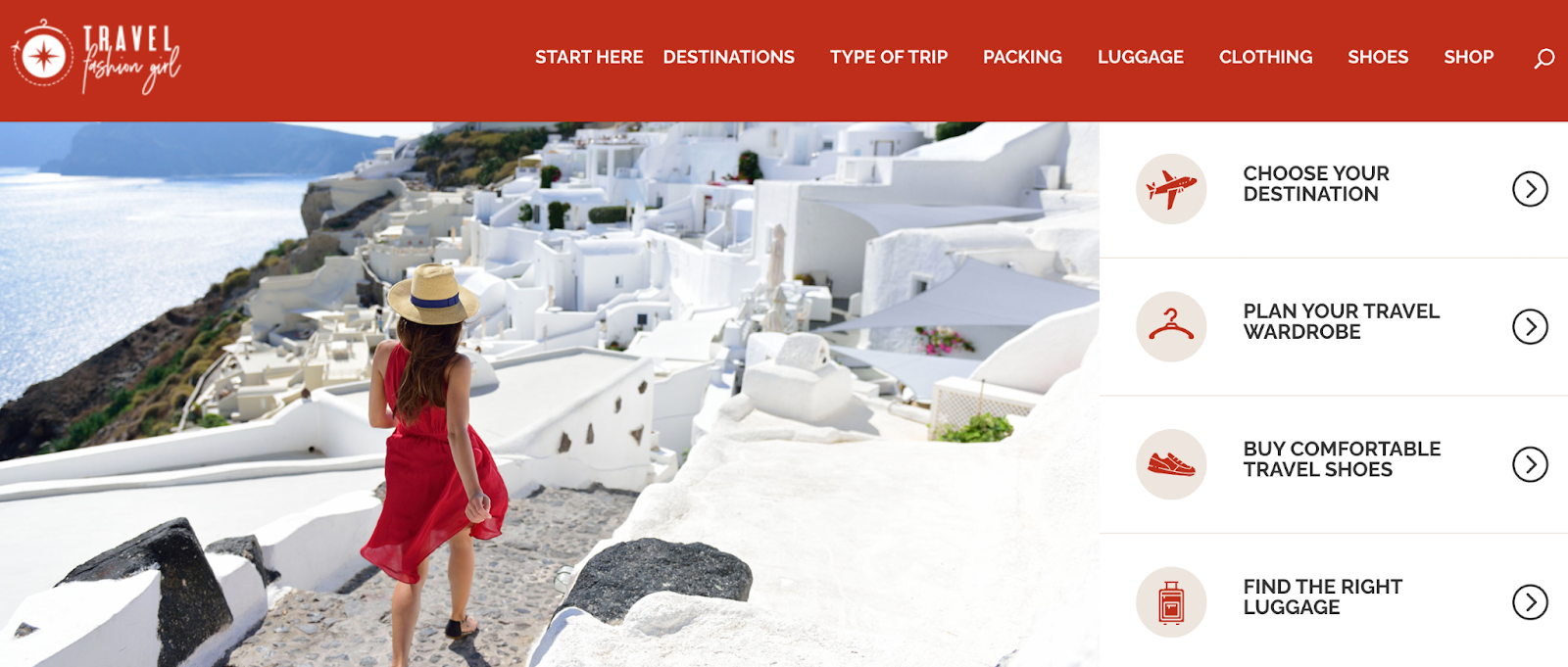
How to Choose Your Travel Niche
The easiest niche to choose is the one you know best. If you’re used to traveling in style, then starting a luxury travel blog makes sense. But if you’ve only slummed it in hostels, it might be harder to create relevant content for a premium audience.
When choosing your travel niche, consider:
- Your past experiences. What kind of experiences have you had previously? Have you done a lot of slow, land travel or have the majority of your trips been cruises?
- Your existing knowledge and interests. What do you know a lot about? You can combine travel with other interests, like art, language, culture, or fashion to create a sub-niche within travel.
- Your personal circumstances. What makes you different from other travel bloggers? Maybe you travel as a family and homeschool your kids or maybe you’re a solo female backpacker traveling through South America.
2. Define Your Audience
Once you’ve chosen your niche, take a look at who your target audience might be. Sometimes it’ll be clear, like the LGBT market, but other times it can be broader. For example, your niche might be luxury travel, but who specifically do you want to target in that niche? Is it wealthy retirees looking to explore far-flung places in style? Or is it busy professionals who love chic city breaks?
Honing in on who you want to target with your travel blog will inspire content ideas and ensure you’re writing relevant posts. And, the more specific you can be with your audience, the easier it is to pitch your blog to companies for sponsorships.
Most brands will have a decent idea about who their audience is, so if you can show you know the demographics of your readers, there’s a much better chance these brands will choose to work with you.
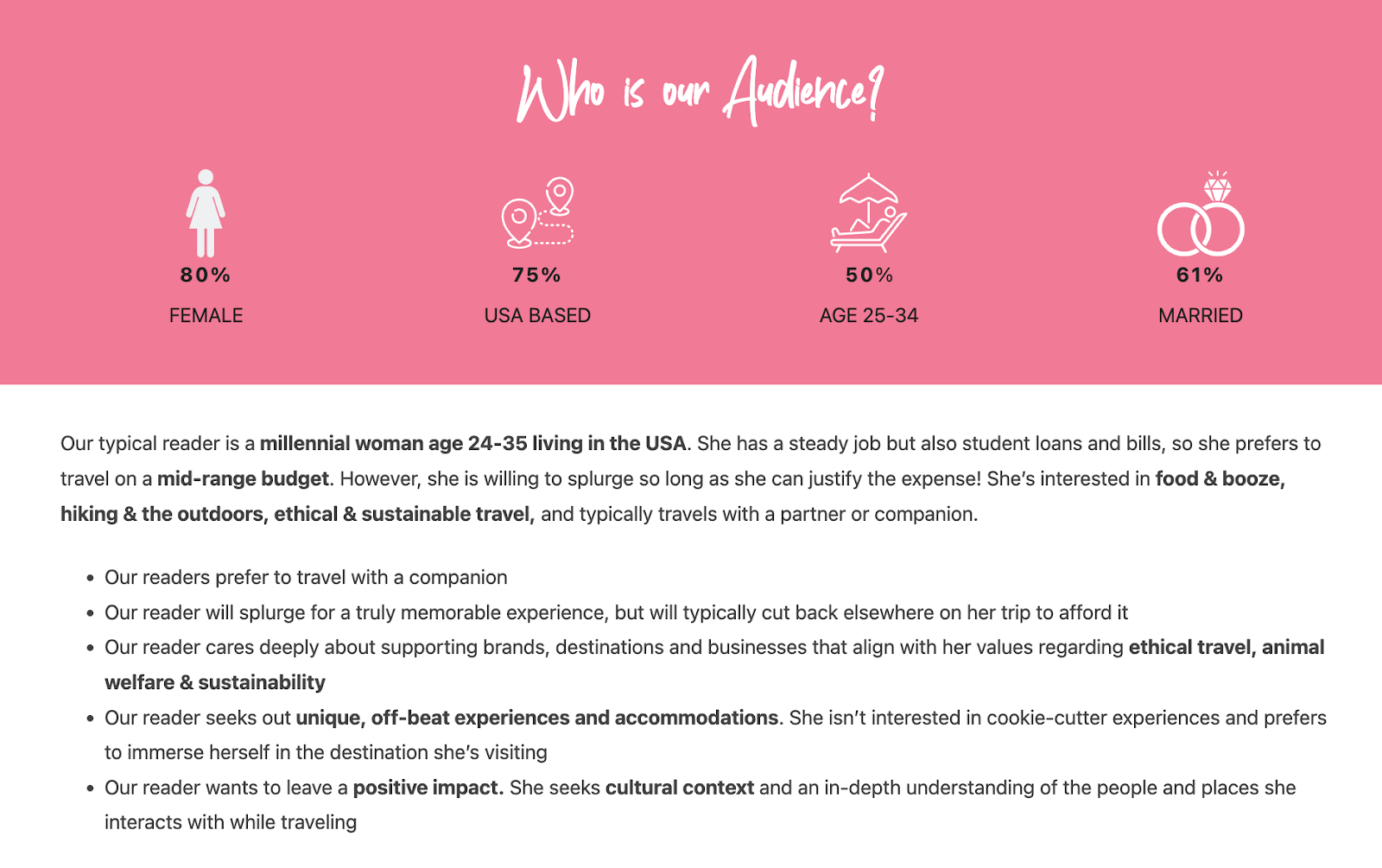
How to choose your target audience
Here are some ways you can uncover your target audience if you’re unsure:
- Research existing blogs. Check out other travel blogs in your niche to see what audiences they’re writing for.
- Explore social media. See who’s following your competitors on social media and what profile they fit.
- Define your interests and knowledge. Lots of travel bloggers start out targeting people just like them—family travelers write for other families and solo backpackers write content for other solo backpackers.
I’d urge you to get as specific as possible with who you want to target. Don’t stop at “young Americans looking for adventure”. Go beyond demographic information like age, location, and lifestyle, and dig into psychographic tendencies.
This can include details like:
- Interests and passions
- Challenges and fears
- Dreams and goals
- Life stages
“20-year-old solo female backpackers who want to deeply explore the culture of the places they visit but are concerned about keeping safe” is better than “20-year-old female backpackers”.
3. Create Your Brand
There are more than 600 million blogs and it’s safe to say a large chunk of those are travel blogs since travel blogs often fall in the top 10 most popular types of blogs (alongside fashion, food, and fitness).
The competition is fierce. But, creating a memorable brand for your blog can help you stand out. A large part of this is choosing the right name, picking your color palette, designing a logo, and developing a brand personality.
I’d warn against spending too much time tweaking the layout of your website (lord knows I spent way too long updating inconsequential details on my travel blog), but it can help you differentiate yourself from the competition if you know who you are and the purpose of your blog.
Here are some things to consider.
Choose a Name For Your Travel Blog
My travel blog was called Wanderful World. It was pun-tastic and I loved it at the time, but over the years it became tiring having to tell everyone it was spelled “wanderful with an ‘a’, not an ‘o’”.
There are four things to consider when choosing your blog’s name:
- Your niche. Ideally, you want people to know exactly what your blog’s about when they land on it. Travel Fashion Girl is a great example of this. So is Green Global Travel, a blog about sustainable, eco-friendly travel.
- The search engines. The more descriptive your travel blog’s name is, the easier it is for Google to understand what it’s about. Including words like travel, nomad, global, and trip are all good indications of what your blog is about.
- Your blog’s future. It’s daunting to think about the future of your blog when you’re just starting out, but it can help to consider where you might want to take it in the future. For example, will you feel restricted if you call it “John Smith’s Travel Blog” but decide later on you want to have other writers contribute?
- Domain availability. Imagine coming up with a name you love, only to find it already exists. When choosing your blog name, run a search to see if the domain is available (you can extend this to social media handles too).
Brainstorm some names you like or use a name generator tool to spark inspiration. When you have a few options, ask friends and family for their input as it can sometimes be difficult to see the wood through the trees when you’re so close to a project.
Design Your Brand Assets
This is the fun part. What do you want your travel blog to look like? This is where you’ll decide on your color palette, logo, and visual assets. Think about what you want your branding to say about your blog. For example, if your blog is about luxury travel, you might want your logo and brand assets to ooze style and class.
Take inspiration from some of the best travel blogs:
- Camels and Chocolate has a modern logo set against a bold yellow and black color scheme.
- Oneika the Traveller has a stylish logo that spells out her name and uses big visuals throughout the site. The rich purple and mustard color scheme reflects the luxury content she posts about.
- Globalmouse Travel’s logo includes an illustration of a mouse exploring the world which aligns with its audience of families.
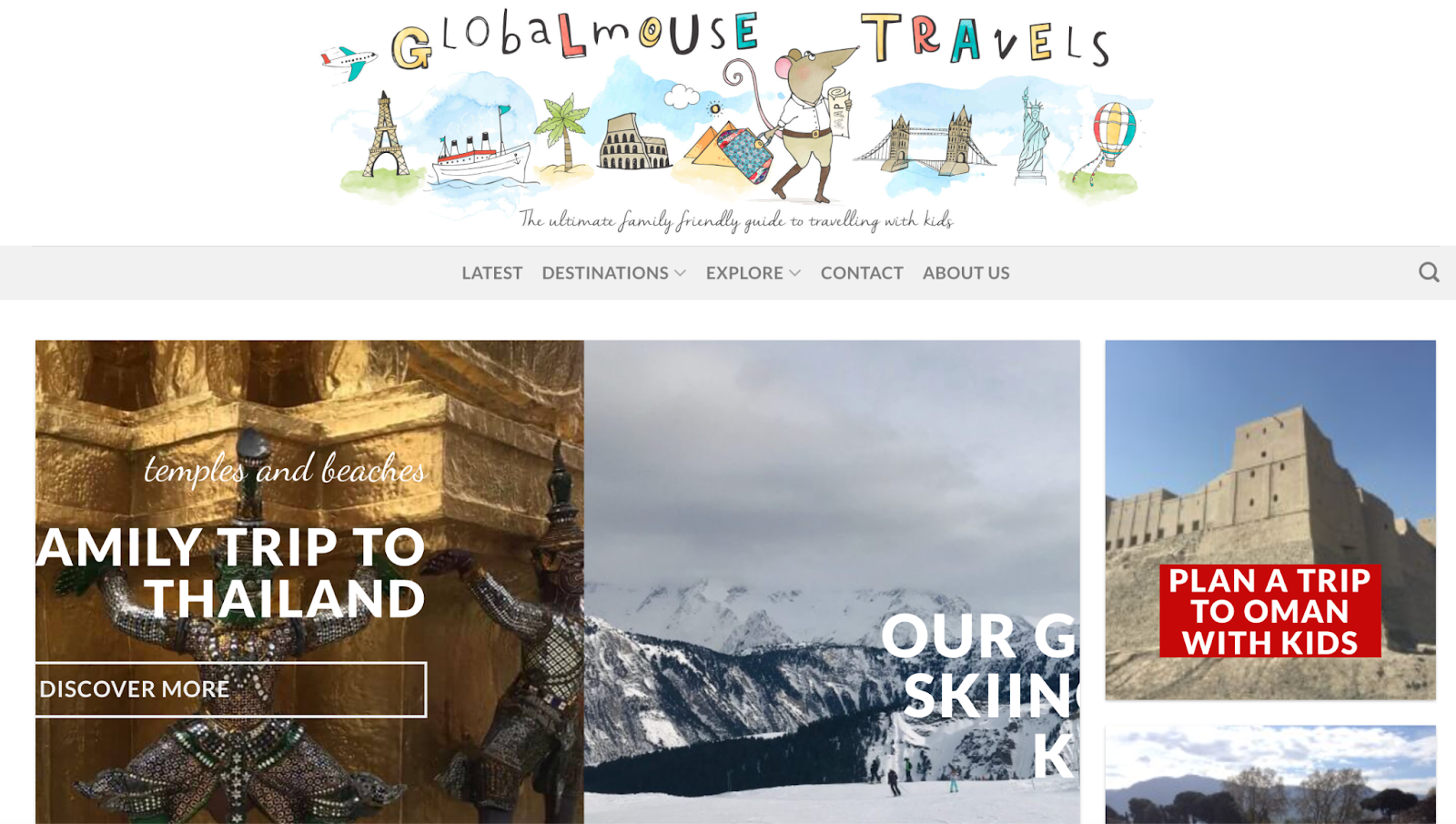
If you’re a dab hand at designing your own graphics, you can create your logo in Photoshop. If not, try a logo generator or a tool like Canva that has customizable templates you can edit to match your brand.
4. Choose a Platform
Next, you’ll need a home for your travel blog. You can use a website builder or a content management system (CMS). Both let you upload content and customize your blog to make it look how you want, but some options are more user-friendly than others.
Here are some platforms to consider:
- WordPress. WordPress is one of the most flexible, customizable blogging platforms, but it can involve a steep learning curve. The backend can be confusing for new bloggers, but the biggest pro is you can access thousands of plugins to essentially make your blog look and operate exactly how you want it to.
- Squarespace. Squarespace is a drag-and-drop website builder with a handful of beautiful templates you can get started with straight away. It’s very customizable, the only downside is its blogging feature can feel quite clunky compared to other platforms.
- WIX. WIX also has several templates you can use and offers a drag-and-drop style builder. While it’s more commonly used to build service-based websites, there is a blog feature you can add.
- Weebly. Weebly’s website builder is flexible, but like Squarespace, the blogging feature can feel glitchy and clunky compared to other options.
Research the pros and cons of each platform and decide what features matter most to you. WordPress is the most common platform, but if you’re not completely tech-savvy and want a quick setup, it might be easier to choose a premade template on Squarespace or WIX.
You’ll also want to purchase your domain name at this point, which is the URL people will type into the search bar to land on your blog. Most of the blogging platforms let you buy a domain as part of the website build, but if you want a cheaper, third-party option, you can look at sites like GoDaddy, Namecheap, and Hostinger.
5. Start Blogging
It’s finally time to write your first post. Remember to keep your target audience and niche in mind when coming up with content ideas. You might already have a few ideas floating around your head after going through the previous steps, so it can be a good exercise to get those down on paper (or screen) and flesh them out.
For example, if yours is a budget travel blog, you might come up with ideas like “best budget places to stay in Rome” or “how to save money for a weekend break”.
You can also use a keyword research tool to find topics that your audience is searching for.
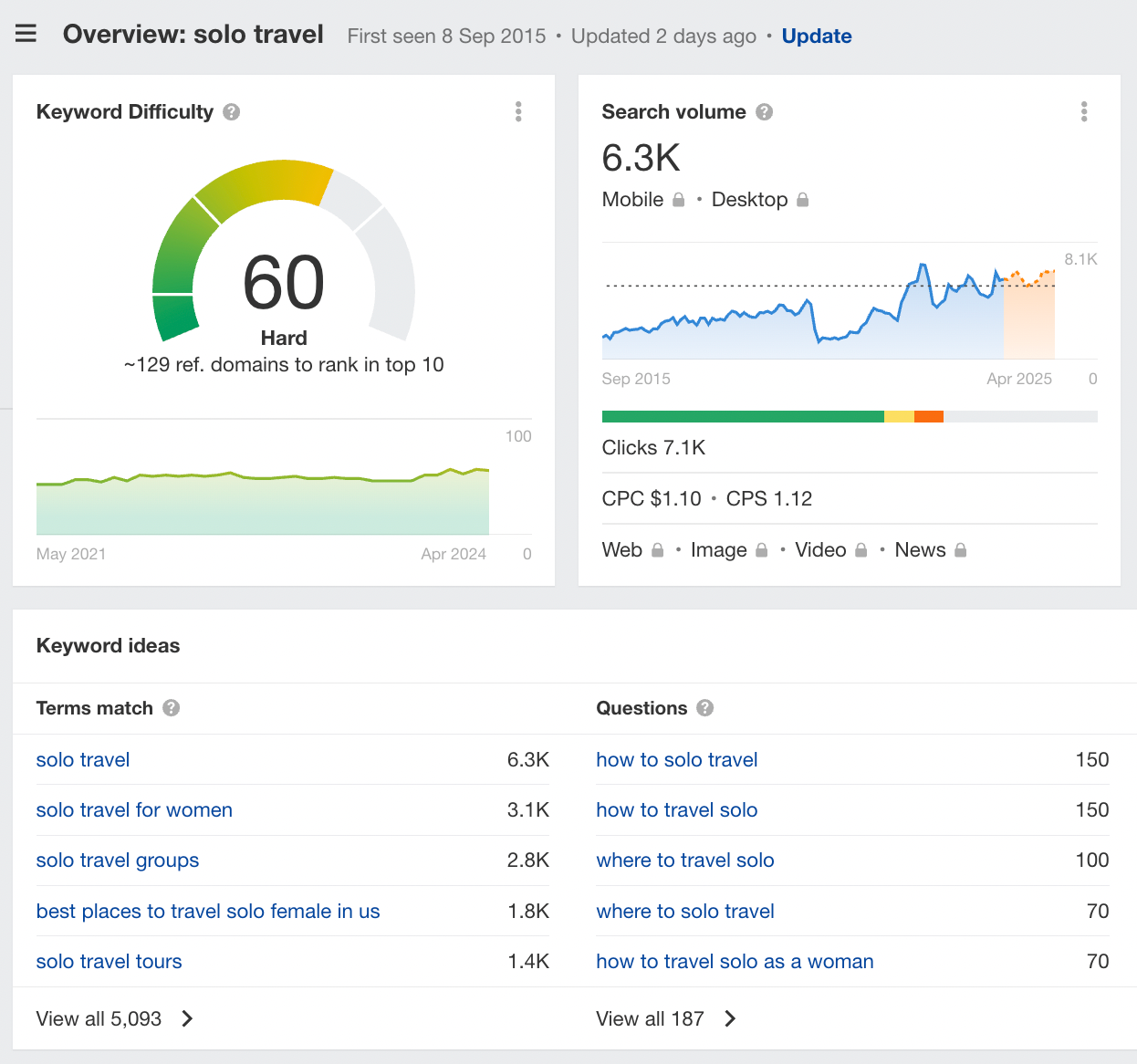
If your blog is about solo travel, you might start with blog posts about solo travel for women or the best places to travel solo. By aligning your content with topics people are searching for, you’re more likely to attract organic search traffic (and, the more visitors you have, the easier it is to partner with brands and monetize your travel blog later down the line).
Here are some tips for writing great content on your travel blog.
- Stay consistent. Only commit to a publishing cadence you can stick to. If that’s only one or two posts a month, that’s fine. The most important thing is that you write posts regularly so your audience anticipates new content.
- Keep it high-quality. Make your blog posts the best out there by including personal anecdotes, stories, and deep dives into a topic. Avoid creating same-y, generic content that hundreds of other blogs have already covered.
- Stand out with visuals. Imagery is important in travel. Include high-quality photos, videos, and other multimedia elements to add context to your blog posts.
- Experiment with different content types. Switch up your blog posts with reviews, guides, reports, and personal stories.
Struggling to come up with content ideas? You can browse social media to find engaging topics, check out what your competitors are posting (and make yours better), answer questions, research statistics, or cover industry trends. The more content you post, the easier it’ll get to determine what kind of blog posts your audience enjoys most.
6. Find Your Audience
When you’ve got a couple of posts under your belt, you can start promoting your travel blog to increase your readership. This is arguably the hardest part of starting a travel blog because it’s hard to know what will work for you until you try it.
I’d encourage you to experiment with a few different marketing strategies to see which ones your audience responds best to. Here are some ideas to get you started.
- Social media. Share your travels on Instagram, X, TikTok, and Facebook. You can use these platforms to grow your audience, share your latest blog posts, and join the travel blogging community.
- Search engine optimization (SEO). Optimize your blog posts with relevant keywords, internal linking, and meta descriptions to increase your visibility in the search results.
- Guest posting. Offer to swap posts with another travel blogger so you can get in front of their audience.
- Partnerships. Pair up with other relevant bloggers to promote each other’s content. You can do this on social media or your blog.
- Attend events. Go to travel blogging events that fit your niche to meet like-minded travelers and grow your network.
- Get involved in forums. Join relevant forums and answer questions so you become a go-to authority in your niche.
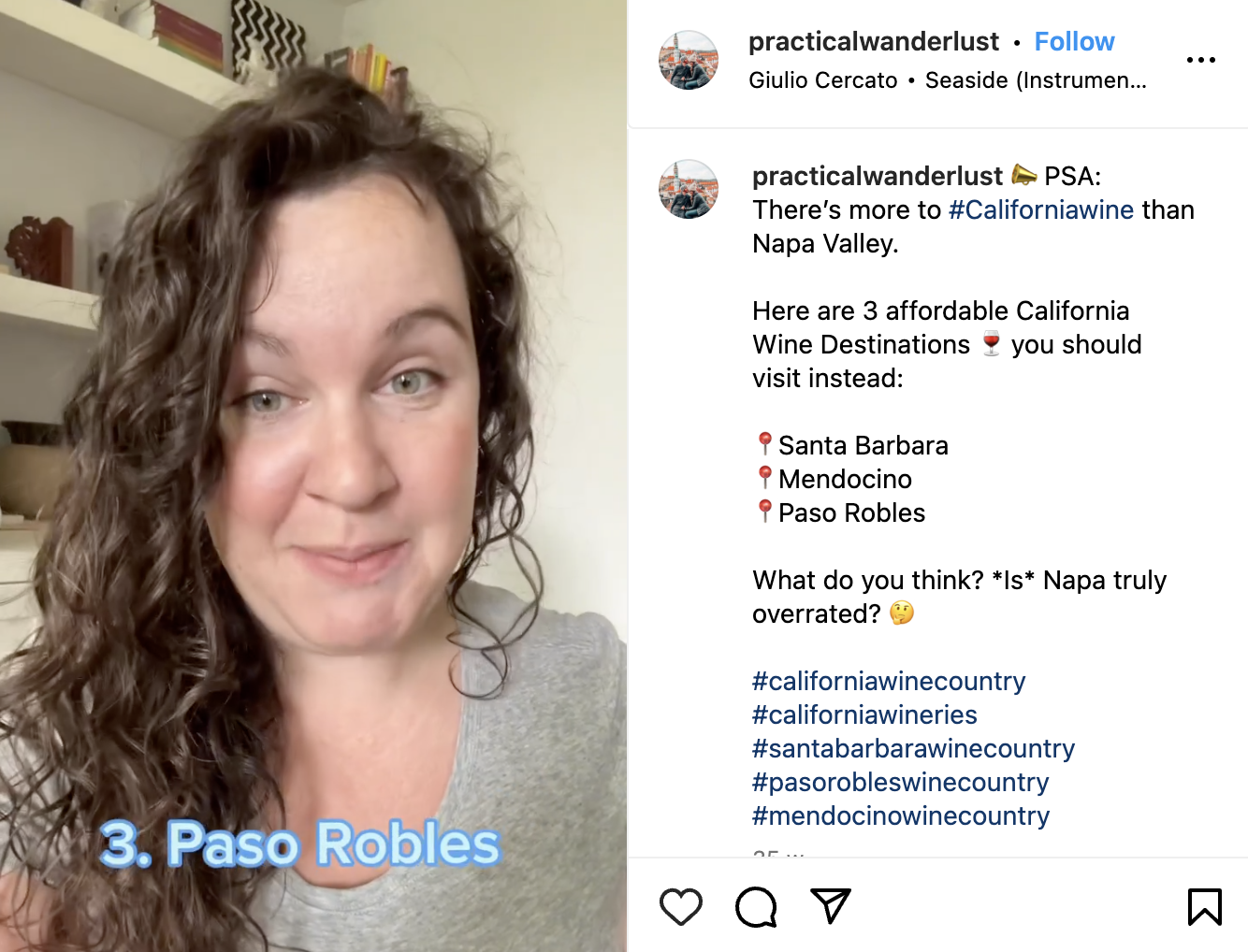
7. Keep Blogging!
Starting a travel blog can feel overwhelming. There are lots of moving parts, but if you love travel and sharing your travel stories, it can be a great creative outlet with monetization opportunities. For me, it was an excellent way to document my travels and meet other like-minded people along the way.
Once you’re all set up, the most important thing is to stay consistent, even when you’re not seeing huge results in the early days. It can take a while for things to pick up, but stick at it and you’ll start to see growth.
If there’s one thing I can recommend, it’s to just keep plugging away. Keep coming up with content ideas, publishing new posts, and promoting your blog in relevant places. Over time, you’ll start to build a loyal readership which can open up a ton of opportunities for making money.
Set Up a Posting Schedule
Once you’ve established how much time you can commit to creating content for your travel blog, set up a posting schedule or a content calendar. This will help you plan what you’re going to post and when. You can also schedule posts in advance to make sure you’re regularly sharing content even when you can’t be at your computer.
Time Block and Bulk Create Content
It’s hard finding the time to write and manage a travel blog—especially if you’re traveling or have other commitments. Try time blocking a couple of hours a week to work on your blog, whether that’s writing new content, networking with other bloggers, or adding revenue streams to make more money. During these hours, you can bulk-create blog posts, edit images, or design social media content to promote your travel blog.
Can You Make Money With a Travel Blog?
In short: yes. As with any type of blogging, it takes time to build an audience and seek out potential monetization opportunities.
Here are some of the most common ways travel bloggers make money.
Advertising

Offer advertising spots to relevant companies or sign up for an advertising network like Google AdSense, which automatically places adverts on your site. You’ll get paid every time a reader clicks on the ad.
Affiliate Links
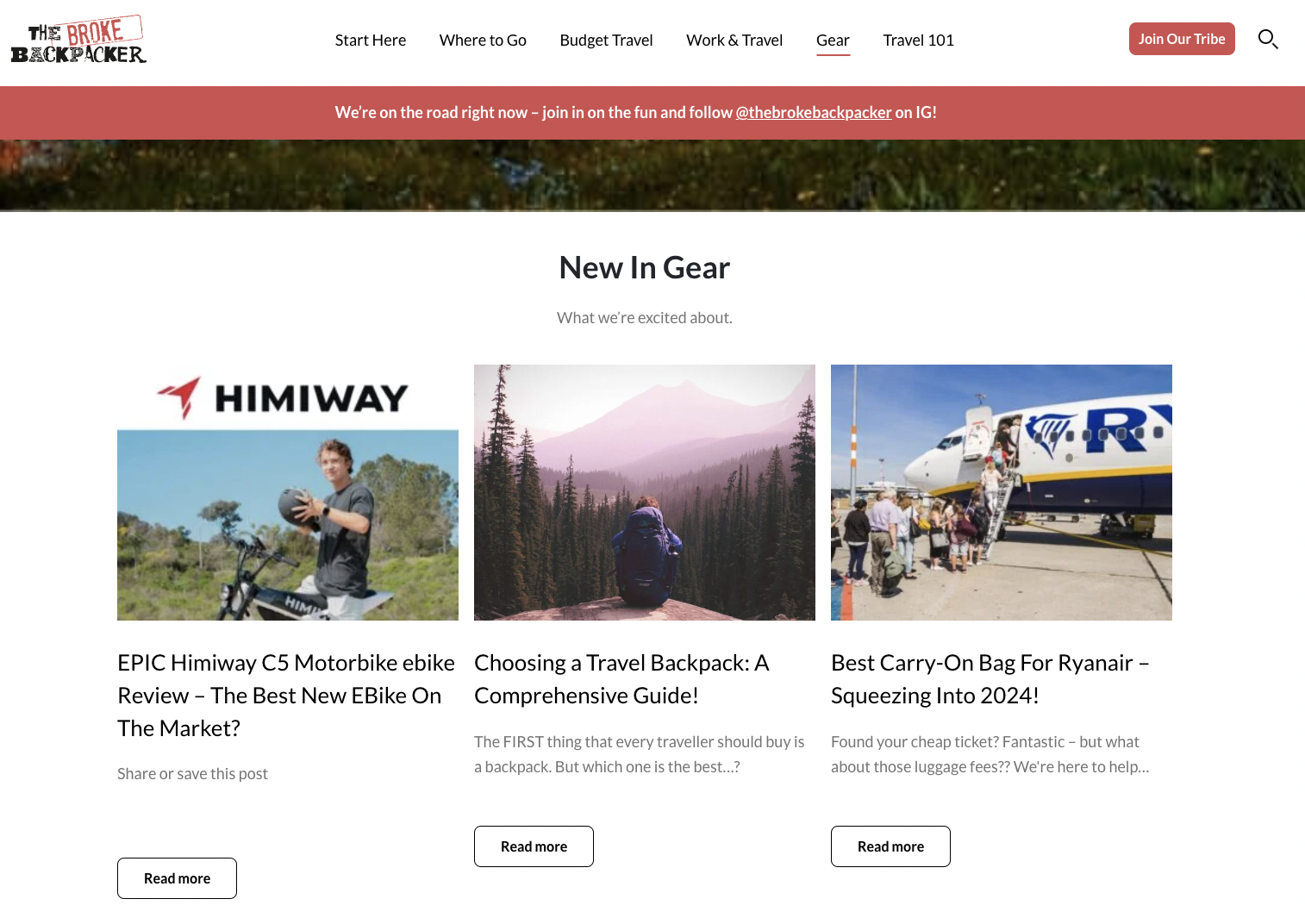
Make a slice of commission every time a reader buys a product or service through your unique affiliate link. Lots of travel bloggers join affiliate programs for accommodation search engines, travel products, and tours. For example, The Broke Backpacker has an entire page on their blog dedicated to product reviews. Each time a reader buys a product they mention through an affiliate link, they get a kickback.
Sponsored Posts
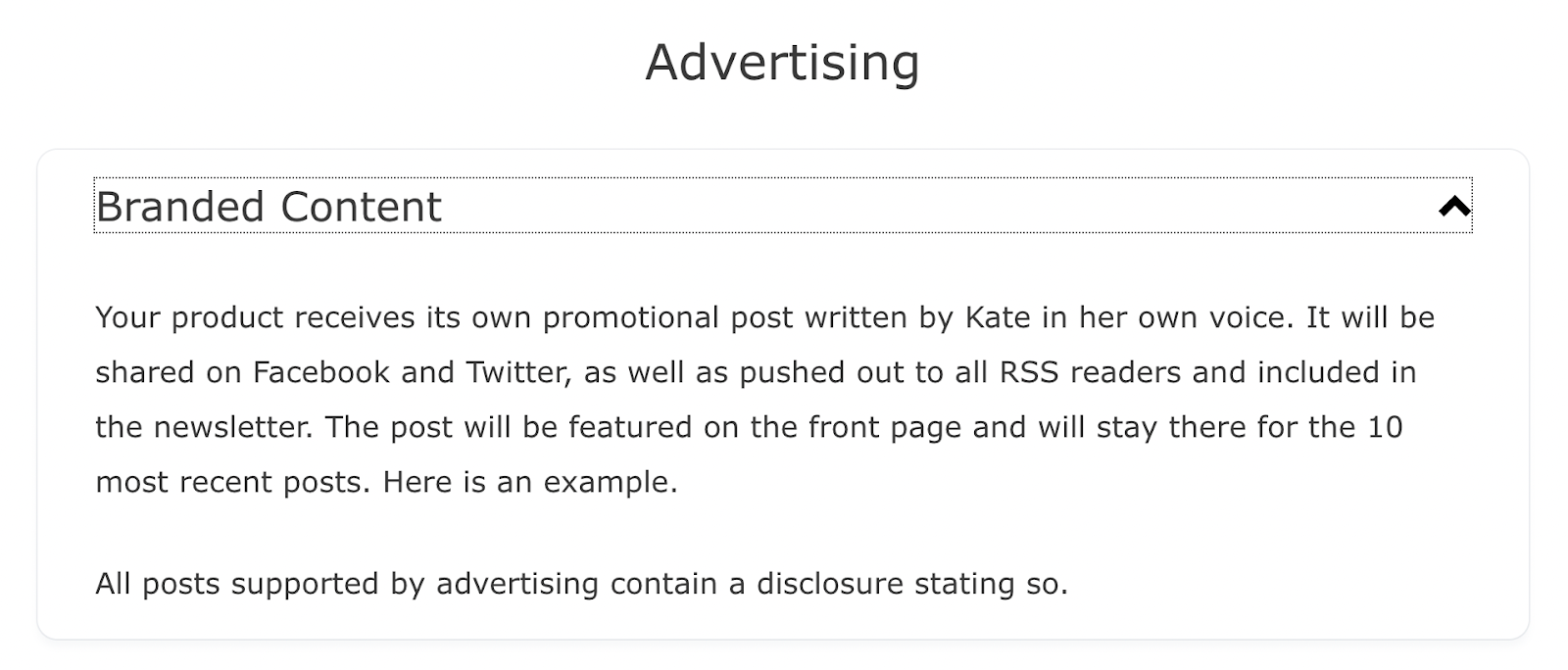
Let brands pay for a sponsored post on your blog. You can either write the post yourself and link to their product or they can write it themselves.
Passive Income
The real money to be made from travel blogging is in passive income gained through exclusive content. We’re talking memberships, newsletters, digital downloads, and exclusive content only available to readers who pay a monthly fee (we’re going to show you how to do this with Whop later on).
But first, let’s take a look at some case studies of travel bloggers who earn good money from blogging.
How Jeremy of 'Living the Dream' Made $6,646 in One Month
Jeremy’s travel blog documents his travels to 79 countries and provides detailed guides to top destinations. In March 2024, he made $6,646 from the blog broken down into the following revenue streams:
- Ads: $3,500
- Affiliate commissions: $2,396
- Facebook bonus: $300
- Consulting: $400
How Amy Fillinger Made $4,223.94 From Her Travel Blog
Travel blogger and travel agency owner Amy Fillinger made over $4,000 in one month through her travel blog. She earned the money solely through ads and affiliate links, getting a slice of commission every time someone bought a car rental or booked accommodation through her.
How One Travel Blogging Couple Made Over $300,000 a Year
Esther and Jacob of Local Adventurer make a habit of sharing their travel blog income online. After running their blog for several years, they’ve consistently made more than $300,000 a year through ads, sponsorships, and affiliate links. They cite sponsorships as their biggest revenue generator, which includes placing paid posts on their blog and partnering with brands to promote their products.
Monetizing Your Travel Blog With Whop
Whop has everything that you need to monetize your travel blog. With Whop, you can make your own hub, which is your space on the internet. Within your hub you can curate a collection of apps that help you to promote your content, build a community, and make money with your travel blog.
For example, as a travel blogger, you of course need a place to share your content (which could be achieved with the Whop Content app, or, you could publish content on your own website and embed this into your Hub).
However, you also need other ways to make income. In your hub you can have:
- courses (why not create 'How to become a travel blogger 101?), community chats (keeping your community connected)
- forums (a great place for Q&A)
- photo galleries (share those inspo pics!)
- downloadables (like packing lists, travel journal PDFs, exclusive images, or travel photo filters)
- giveaways (a great way to partner with brands and reward your fanbase)
- live videos
and so much more —everything you need to grow a loyal audience and create a community around your travel blog.
As mentioned, you can use the collection of apps to tailor the user experience. Your readers then pay to access your Whop and all the juicy content and features you’ve built inside it. Levels of access can also be tiered, so that you can offer something for everyone.
Ready to Share Your Travel Journey?
Starting a travel blog can be a great way to document your travels and remember those life-changing trips—that’s the reason I started mine. But once you’ve created a platform for your stories and start building an audience, plenty of other opportunities rear their heads. In less than two years of running my blog, I’d secured sponsored trips to Copenhagen and Cyprus and had made extra income selling paid posts and ads on my website.
It’s easy to get started. You can start designing and building your blog once you’ve chosen your niche and audience. There’s so much more tech available today than when I started, so it’s easier than ever to get set up and start getting paid.
When you sign up for Whop, you can build out your hub, adding content, forums, and exclusive downloads to grow your audience and make money.
Travel Blog FAQs
How much does it cost to start a travel blog?
It’s fairly cheap to start a travel blog. The only things you need to spend money on are your domain name and your website builder. Domain names can be as cheap as $5 and website builders often charge a monthly fee (for example, Squarespace charges about $20 a month to host your blog).
The better (and cheaper) option is to create a Whop. It’s free to start your hub and Whop just takes a 3% fee on sales.
How do travel bloggers make money?
Travel bloggers usually make money by placing ads on their websites, sharing affiliate links to relevant travel products, and offering paid sponsored posts to brands. Bloggers with larger audiences tend to branch out and create other revenue streams, such as selling premium content, becoming travel influencers, creating memberships, and running online courses.
How much money can you make travel blogging?
How much money you make as a travel blogger will depend on how you monetize your blog and the size of your audience. Some bloggers make $22,000 in their first year and others can make $327,270 in a few months. Don’t expect to make millions straight away. It takes time to build a readership and start earning. As a general rule, you can expect anything up to $10,000 a month—more, if you have a particularly large following.
Can you start a travel blog without actually traveling?
In short: yes. Plenty of travel bloggers aren’t full-time travelers. In fact, many have full-time jobs, especially when they’re starting. I never traveled full-time during my travel blogging career, but I did take several trips a year that I documented. It helps if you have lots of experiences to pull stories from, but you can also create content around travel in other ways, like the best backpack reviews or how to find cheap flights.
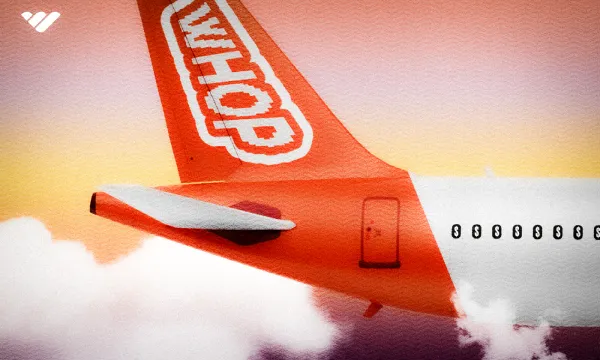

![60 easy ways to make money online [2025]](/blog/content/images/size/w600/2023/11/20-ways-to-make-money-online--1-.webp)

![80 remote side hustles that you can do from anywhere [2025]](/blog/content/images/size/w600/2024/08/30-remote-side-hustles-that-you-can-do-from-anywhere.webp)
